handheld sewing machine instructions pdf
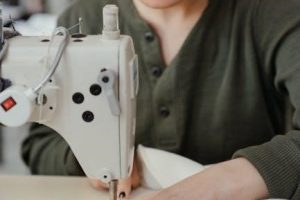
Handheld sewing machines offer portable‚ lightweight‚ and easy-to-use solutions for quick repairs and small projects. They are ideal for DIY enthusiasts and crafters‚ providing versatility and convenience.
1.1 What is a Handheld Sewing Machine?
A handheld sewing machine is a compact‚ portable device designed for small-scale sewing tasks. It is battery-operated and ideal for quick repairs‚ DIY crafts‚ and small fabric projects. Unlike traditional machines‚ it is lightweight and easy to maneuver‚ making it perfect for beginners or those needing convenience. The machine typically includes basic features like adjustable tension and a simple threading system. Instructions for use‚ often found in downloadable PDF guides‚ cover essential steps such as loading batteries‚ threading‚ and maintenance. Popular brands like Spring Come and Handy Stitch offer models suitable for various fabrics‚ including denim‚ proving versatile for crafters and hobbyists alike.
1.2 Benefits of Using a Portable Sewing Machine
Using a portable sewing machine offers numerous advantages‚ especially for beginners and crafters. Its compact size allows for easy transport‚ making it ideal for on-the-go projects or small workspaces. The machine simplifies quick repairs‚ such as mending clothes or upholstery‚ without the need for a bulky traditional sewing machine. Additionally‚ it is cost-effective and requires minimal setup‚ making it accessible to those new to sewing. The availability of instructional PDF guides ensures users can quickly learn to operate the machine‚ while its versatility in handling various fabrics adds to its appeal. This convenience makes it a practical tool for both hobbyists and professionals seeking efficient solutions for minor sewing tasks.
1.3 Who Can Benefit from a Handheld Sewing Machine?
Handheld sewing machines are ideal for hobbyists‚ DIY enthusiasts‚ and beginners seeking to learn sewing basics. They are perfect for quick repairs‚ crafting‚ and small projects‚ making them a great tool for students and teachers. Fashion enthusiasts and upcyclers can also benefit‚ as they allow for creative embellishments and fabric manipulation. Professionals needing portable solutions for minor adjustments or custom work will find these machines convenient. Additionally‚ travelers or workshop attendees who require a lightweight‚ easy-to-use option will appreciate their portability and efficiency. Overall‚ anyone looking for a versatile‚ user-friendly sewing solution can gain value from a handheld sewing machine.
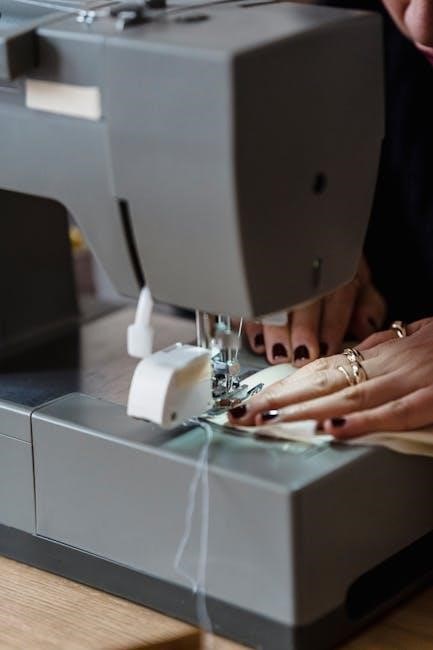
Understanding the Components of a Handheld Sewing Machine
A handheld sewing machine consists of a needle‚ battery compartment‚ and threading mechanism. These components work together to enable easy stitching and portability for various sewing tasks.
2.1 Overview of the Machine’s Parts
A handheld sewing machine typically includes a needle‚ a battery compartment‚ a threading mechanism‚ and a power switch. The needle is essential for creating stitches‚ while the battery powers the machine. The threading mechanism allows users to guide the thread through the machine‚ ensuring proper stitch formation. Some models may also include additional features like adjustable tension or a small LED light for better visibility. Understanding these components is crucial for effective operation and maintenance. Always refer to the handheld sewing machine instructions PDF for specific details about your model‚ as parts may vary slightly between brands and designs. Proper assembly and alignment of these parts ensure smooth sewing experiences.
2.2 Importance of the Needle and Thread
The needle and thread are critical components of a handheld sewing machine‚ directly affecting stitch quality and performance. A standard sewing machine needle ensures proper penetration of fabric and consistent stitching. The thread must be suitable for the fabric type and machine specifications to avoid breaks or tangles. Improper threading or using a damaged needle can lead to uneven stitches or machine malfunction; Regularly inspect and replace the needle to maintain optimal sewing results. Always use high-quality thread recommended for handheld machines to ensure smooth operation. Proper alignment and tension of the thread are also essential for achieving professional-looking stitches. Refer to the handheld sewing machine instructions PDF for guidance on needle replacement and thread selection.
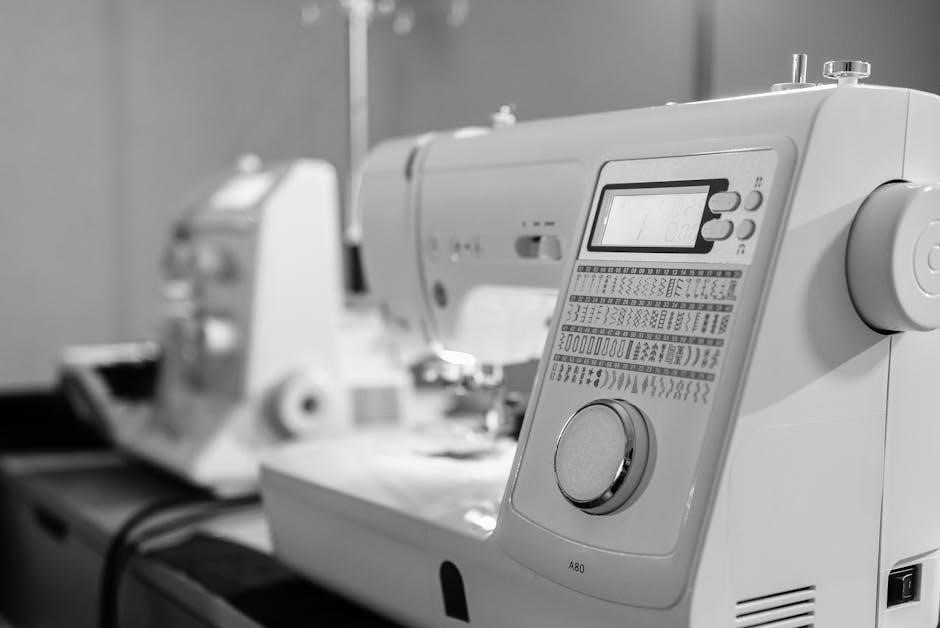
2.3 Role of Batteries in Portable Sewing Machines
Batteries are the power source for handheld sewing machines‚ enabling portability and ease of use. Most machines require standard AA or rechargeable batteries‚ which power the motor to drive the needle and thread. Properly loaded batteries ensure consistent stitching and optimal performance. Always use the recommended battery type‚ as specified in the handheld sewing machine instructions PDF‚ to avoid machine malfunction. Low battery power can result in slow or uneven stitching‚ so regular checks and replacements are essential. Store batteries separately when not in use to prolong their lifespan. Refer to the guide for troubleshooting battery-related issues‚ such as sudden power loss or failure to turn on.
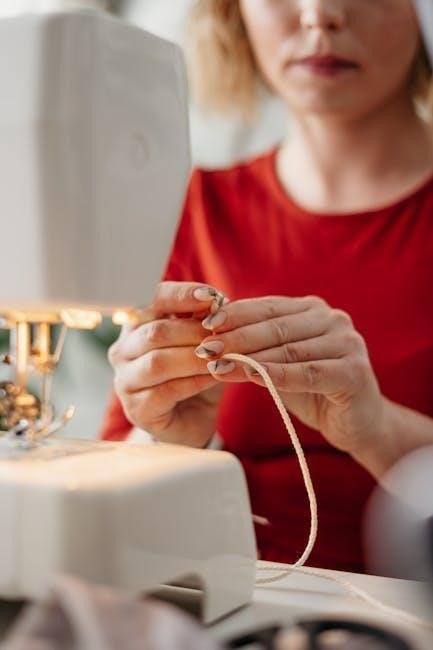
Safety Precautions and Maintenance
Always handle the machine with care‚ avoiding sharp edges. Keep it out of children’s reach and use original parts. Regular cleaning prevents dust buildup and ensures smooth operation. Store the machine in a dry place to maintain functionality and longevity. Refer to the handheld sewing machine instructions PDF for detailed maintenance tips.
3.1 Essential Safety Tips for Beginners
Safety is paramount when using a handheld sewing machine. Always read the handheld sewing machine instructions PDF thoroughly. Keep the machine out of children’s reach and avoid handling it with wet hands. Use the correct needle type for your fabric to prevent breakage. Avoid overloading the machine‚ as this can cause damage or malfunction. Never touch the needle with bare hands‚ and keep loose clothing tied back while sewing. Store the machine in a dry place‚ away from direct sunlight. Regularly inspect the machine for worn parts and replace them as needed. Proper handling ensures safe and efficient sewing experiences.
3.2 Cleaning and Maintaining the Machine
Regular cleaning and maintenance are crucial for the longevity of your handheld sewing machine. Turn off the machine and unplug it before cleaning. Use a soft brush or cloth to remove dust‚ lint‚ and debris from the exterior and internal parts. Avoid using harsh chemicals or liquids‚ as they may damage the components. For stubborn lint‚ a small vacuum cleaner or compressed air can be used gently. Check the needle and thread guide for tangled threads and clear them carefully. If your machine requires oil‚ use only the recommended type and apply it sparingly. Refer to the handheld sewing machine instructions PDF for specific guidance. Proper maintenance ensures smooth operation and extends the machine’s lifespan.
3.3 Storage Tips for Longevity
To ensure your handheld sewing machine lasts‚ proper storage is essential. Store it in a protective case or pouch to shield it from dust and damage. Keep the machine in a dry‚ cool place‚ avoiding direct sunlight or moisture. Extreme temperatures can harm the motor and battery. Always store the machine with the needle in the “up” position to prevent damage. If storing for an extended period‚ remove the battery to avoid corrosion. Secure any loose parts‚ like the presser foot‚ to prevent misplacement. For detailed storage guidelines‚ consult the handheld sewing machine instructions PDF. Proper storage will keep your machine in great condition for future use.
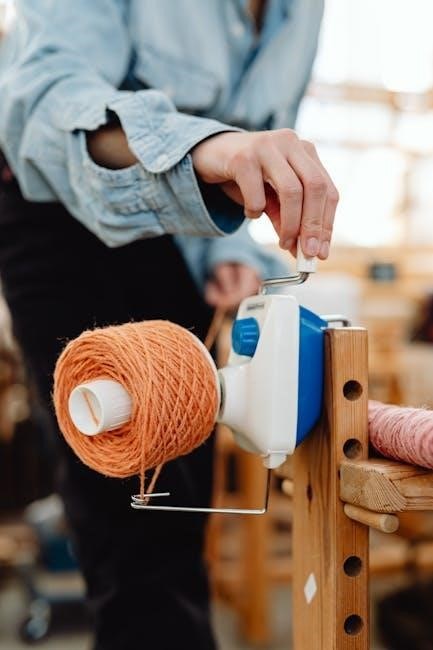
Step-by-Step Setup Guide
Unpack‚ install batteries‚ and thread the machine as outlined in the handheld sewing machine instructions PDF. Adjust the tension and test on scrap fabric before sewing.
4.1 Loading Batteries Correctly
Refer to the handheld sewing machine instructions PDF for specific guidance on battery installation. Ensure the machine is turned off before loading batteries. Open the battery compartment‚ usually located at the base or side‚ and insert the recommended type and size of batteries as specified in the manual. Pay attention to the polarity markings (+ and -) to avoid improper installation‚ which could damage the machine. Once batteries are correctly placed‚ close the compartment securely. Turn the machine on to test if it powers up. If it doesn’t‚ double-check the batteries and their alignment. Proper battery installation ensures smooth operation and prevents malfunctions. Always use fresh‚ high-quality batteries for optimal performance.
4.2 Threading the Machine Properly
Threading your handheld sewing machine correctly is crucial for smooth operation. Refer to the handheld sewing machine instructions PDF for a detailed diagram. Start by turning off the machine and locating the spool pin. Insert the thread through the pin‚ then guide it through the tension control and take-up lever. Follow the path indicated in the manual to ensure proper alignment. Use the correct type of thread recommended for your machine. Gently pull the thread to remove any slack and ensure it’s seated correctly. Avoid pulling too tightly‚ as this could misalign the tension. Test the thread by sewing on a scrap piece of fabric. If the thread doesn’t move smoothly‚ re-thread the machine‚ following the PDF guide carefully. Proper threading ensures even stitching and prevents thread breaks.
4.3 Adjusting the Tension for Optimal Stitching
Adjusting the tension on your handheld sewing machine is essential for achieving consistent and even stitches. Refer to the handheld sewing machine instructions PDF for guidance. Locate the tension adjustment dial‚ typically found near the needle area. Turn the dial clockwise to tighten the tension for thicker fabrics or counterclockwise to loosen it for delicate materials. Test the stitches on a scrap piece of fabric after each adjustment. Proper tension ensures that the thread flows smoothly and evenly‚ preventing puckering or loose stitching. Avoid over-tightening‚ as this can cause thread breakage. If the stitches remain uneven‚ consult the PDF guide for troubleshooting tips. Correct tension settings are vital for professional-looking results.
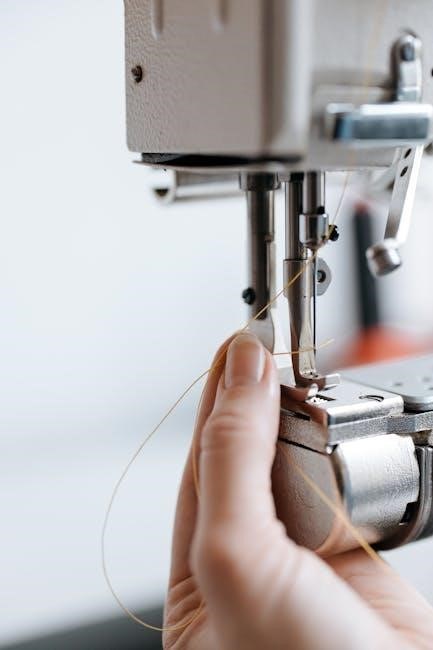
Troubleshooting Common Issues
Addressing common problems with handheld sewing machines ensures smooth operation. Issues like uneven stitching‚ jammed mechanisms‚ or battery drain can be resolved with basic troubleshooting steps. Always refer to the handheld sewing machine instructions PDF for specific guidance. Regular maintenance‚ such as cleaning and proper threading‚ often prevents these issues. If stitches are inconsistent‚ check thread tension and adjust as needed. For jams‚ gently remove tangled thread without forcing. Battery life can be extended by turning off the machine when not in use. Consulting the PDF guide provides detailed solutions for various malfunctions‚ helping you get back to sewing efficiently.
5.1 Why the Machine Might Not Be Stitching
If your handheld sewing machine isn’t stitching‚ several factors could be at play. First‚ ensure the machine is turned on and has adequate battery power. Incorrect threading is a common issue; refer to the handheld sewing machine instructions PDF for proper threading techniques. Check if the needle is correctly inserted and facing the right direction. Improper tension settings or using the wrong type of thread can also prevent stitching. Additionally‚ ensure the fabric is placed correctly under the needle and that there are no obstructions. If the issue persists‚ consult the PDF guide for model-specific troubleshooting steps to resolve the problem quickly and effectively.
5.2 Fixing Jammed or Uneven Stitches
If your handheld sewing machine produces uneven or jammed stitches‚ address the issue by first checking the thread tension. Refer to the handheld sewing machine instructions PDF for guidance on adjusting tension settings. Ensure the needle is properly inserted and facing the correct direction. Uneven stitches may result from incorrect fabric handling or using the wrong needle type. To fix jams‚ gently remove the thread and clear any debris. Restart sewing on a scrap fabric to test the machine’s performance. If stitches remain uneven‚ consult the PDF guide for troubleshooting steps specific to your machine model. Proper technique and regular maintenance can help prevent these issues and ensure smooth stitching.
5.3 Solving Battery Drain Problems
Battery drain in handheld sewing machines can disrupt your workflow. To address this‚ ensure you’re using the correct charger and avoid overcharging‚ as it can reduce battery lifespan. Turn off the machine when not in use‚ as standby mode can drain power. Check for loose battery connections and clean terminals regularly. If the machine is used frequently‚ consider investing in a spare battery. Refer to the handheld sewing machine instructions PDF for specific charging guidelines. Using high-quality‚ compatible batteries and maintaining proper charging habits can help prolong battery life and prevent drainage issues. These simple steps ensure consistent performance during your sewing projects.
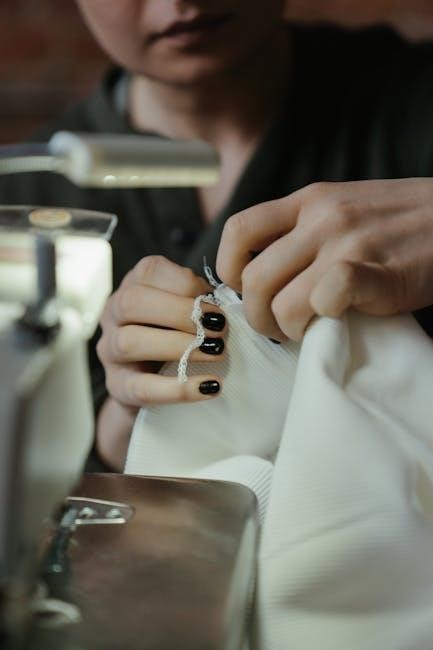
Tips for Effective Sewing with a Handheld Machine
Use the right fabric and thread type for your project. Keep the machine well-maintained and follow the handheld sewing machine instructions PDF for optimal performance. Always test stitches on scrap fabric before sewing your final piece to ensure proper tension and alignment. Practice sewing straight lines and curves to improve control. Regularly clean and oil the machine to prevent jams. Store it safely to avoid damage. These tips will help you achieve professional results with your portable sewing machine‚ making your projects easier and more enjoyable. Consistent practice enhances your sewing skills over time.
6.1 Choosing the Right Fabric for Portable Sewing
When using a handheld sewing machine‚ selecting the right fabric is crucial for smooth operation. Lightweight fabrics like cotton‚ silk‚ and thin polyester work best‚ as they are easy to maneuver. Avoid heavy or thick materials‚ such as denim or canvas‚ as they may cause the machine to struggle or jam. Always pre-wash fabrics to remove sizing and shrinkage‚ ensuring better stitch quality. Refer to the handheld sewing machine instructions PDF for specific fabric recommendations. Testing fabric compatibility beforehand can save time and prevent frustration during your sewing projects. Proper fabric choice enhances portability and efficiency‚ making your handheld sewing experience more enjoyable and productive.
6.2 Managing Thread Tangles and Breaks
Thread tangles and breaks are common issues when using a handheld sewing machine. To prevent these‚ always use high-quality thread suitable for portable machines. Avoid over-tightening the thread‚ as this can cause breakage; Regularly clean the machine’s thread pathway to remove lint and debris. If a tangle occurs‚ gently unwind the thread without pulling forcefully. For breaks‚ rethread the machine carefully‚ following the guide in the handheld sewing machine instructions PDF. Using a thread conditioner can also reduce friction and minimize breakage. Proper thread management ensures smoother sewing and extends the machine’s lifespan. Always test thread tension before starting a project to avoid mid-stitch interruptions.
6.3 Sewing in Different Directions and Patterns
Sewing in different directions and patterns with a handheld machine requires careful control of fabric movement. For straight lines‚ gently guide the fabric in a consistent direction. To sew curves or circles‚ move the fabric smoothly‚ maintaining even pressure. For zigzag patterns‚ alternate the fabric’s direction slightly with each stitch. Always keep the machine flat and stable on the fabric to ensure accurate stitching. Using a stabilizing material like interfacing can help manage slippery fabrics. For intricate designs‚ refer to the handheld sewing machine instructions PDF for guidance on speed and technique. Practice on scrap fabric to master various patterns before working on actual projects. This ensures professional-looking results with minimal effort.
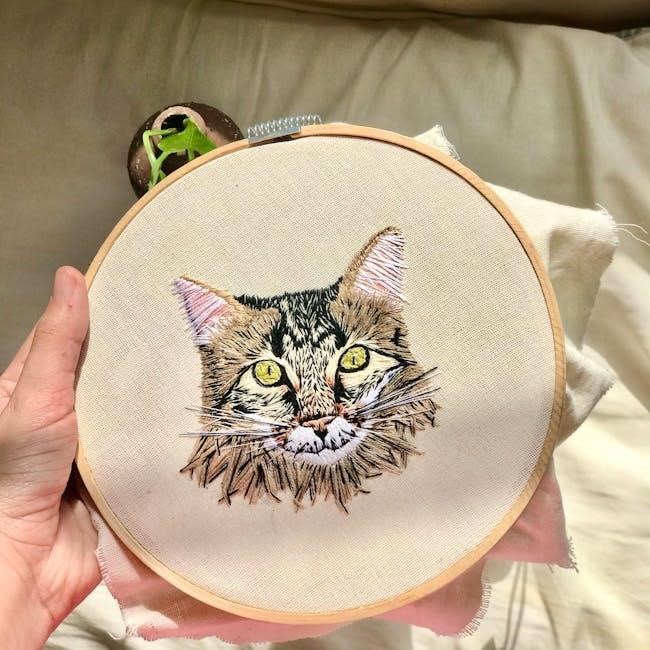
Popular Projects for Handheld Sewing Machines
Explore creative DIY projects with handheld sewing machines‚ including crafting patches‚ bags‚ home decor‚ repairing clothes‚ and creating custom embellishments‚ all covered in the PDF guide.
7.1 Simple DIY Crafts for Beginners
Start your handheld sewing journey with easy DIY projects like sewing small pouches‚ coin purses‚ or fabric coasters. These projects are perfect for practicing basic stitching and understanding fabric handling. Pillowcase edges and simple hemming are also great for beginners. Try making a drawstring bag or a fabric keychain to build confidence. These small crafts help master thread management and machine control. They are ideal for learning how to navigate fabric and maintain consistent stitches. Plus‚ they make thoughtful gifts or useful items for daily life; The PDF guide provides step-by-step instructions for these projects‚ ensuring a smooth learning process for newcomers to portable sewing.
7.2 Repairing Clothes with a Portable Machine
Repairing clothes with a handheld sewing machine is a practical way to extend the life of your wardrobe. Start by addressing small tears‚ loose buttons‚ or frayed hems. Torn seams can be quickly mended by sewing along the edge. For holes‚ reinforce the area with a patch before stitching. The machine’s portability allows you to fix clothes on the go‚ making it ideal for last-minute repairs. Use the PDF guide to learn how to thread the machine and adjust tension for secure stitches. Practice on scrap fabric first to ensure neat‚ even sewing. This skill is essential for saving money and reducing textile waste by giving old clothes a new life.
7.3 Creating Custom Embellishments
Handheld sewing machines are perfect for adding unique‚ personalized touches to fabrics. Use them to create custom embellishments like decorative stitches‚ appliques‚ or monograms. Start by selecting suitable fabrics and threads that match your project’s theme. The machine’s portability allows for intricate designs on small or hard-to-reach areas. Experiment with zigzag patterns or straight stitches to add texture and visual interest. For delicate materials like silk or denim‚ adjust the tension to ensure smooth stitching. Refer to the PDF guide for tips on thread color selection and stitch length. With practice‚ you can craft one-of-a-kind designs‚ turning ordinary items into personalized gifts or statement pieces. This versatility makes handheld machines a must-have for creative crafting.
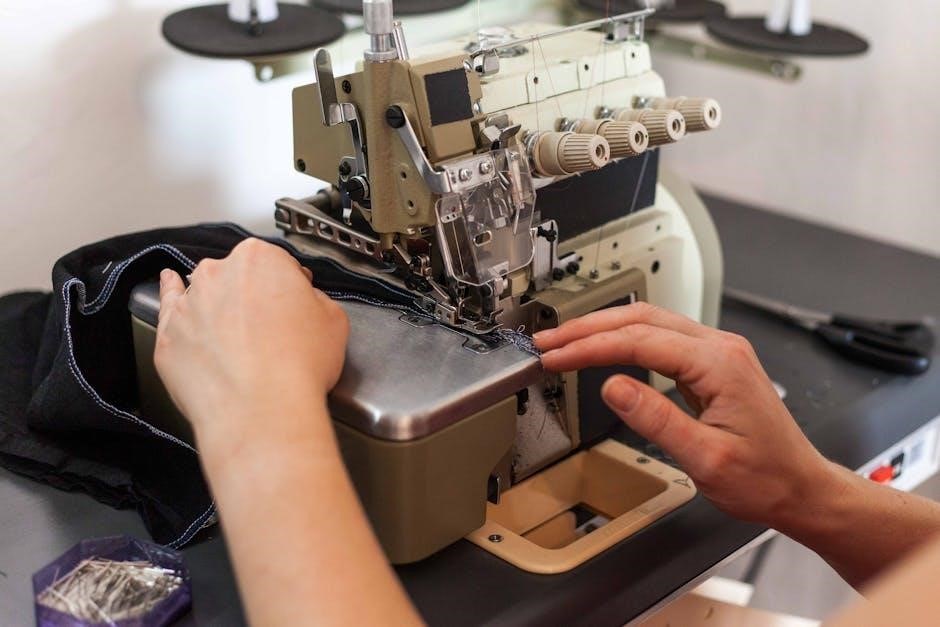
Comparing Handheld Sewing Machines with Traditional Machines
Handheld machines are portable and battery-powered‚ ideal for small repairs‚ while traditional machines are bulky and electric‚ offering more power and features for heavy-duty tasks.
8.1 Differences in Functionality
Handheld sewing machines are designed for portability and simplicity‚ offering basic stitching functions for small repairs or lightweight fabrics. They are battery-powered‚ cordless‚ and lightweight‚ making them ideal for on-the-go use. Traditional sewing machines‚ however‚ are larger‚ more powerful‚ and typically electric. They provide a wider range of stitch options‚ higher sewing speeds‚ and the ability to handle thicker materials like denim or leather. Traditional machines often include additional features like automatic threading‚ tension control‚ and interchangeable presser feet‚ catering to complex sewing projects. While handheld machines excel in convenience‚ traditional machines are better suited for heavy-duty tasks and professional-grade sewing needs. Functionality differs based on size‚ power‚ and versatility.
8.2 Pros and Cons of Each Type
Handheld sewing machines are highly portable and ideal for quick repairs or small projects‚ offering convenience and ease of use. They are lightweight‚ affordable‚ and require minimal setup. However‚ they lack the power and versatility of traditional machines‚ struggling with thick fabrics and offering limited stitch options. Traditional sewing machines‚ while bulkier and more expensive‚ provide superior stitch quality‚ durability‚ and versatility for complex projects. They support various fabrics and stitches but require more space and setup. Handheld machines are perfect for beginners or casual use‚ while traditional machines cater to serious sewists or professionals needing advanced capabilities. Each type has its strengths and weaknesses based on user needs and project requirements.
8.3 When to Use a Handheld vs. Traditional Machine
Handheld sewing machines are best for small‚ quick tasks like repairing clothes‚ stitching curtains‚ or crafting DIY projects. They excel in portability and ease of use‚ making them ideal for beginners or on-the-go sewing. Traditional machines‚ however‚ are better suited for heavy-duty sewing‚ such as quilting‚ upholstery‚ or large-scale projects requiring multiple layers or complex stitches. Use handheld machines for lightweight fabrics and simple repairs‚ while traditional machines are optimal for thick materials‚ embroidery‚ or professional-grade results. Choose based on project size‚ fabric type‚ and desired precision to maximize efficiency and achieve the best outcomes. Each machine type shines in specific scenarios‚ catering to different sewing needs and skill levels.
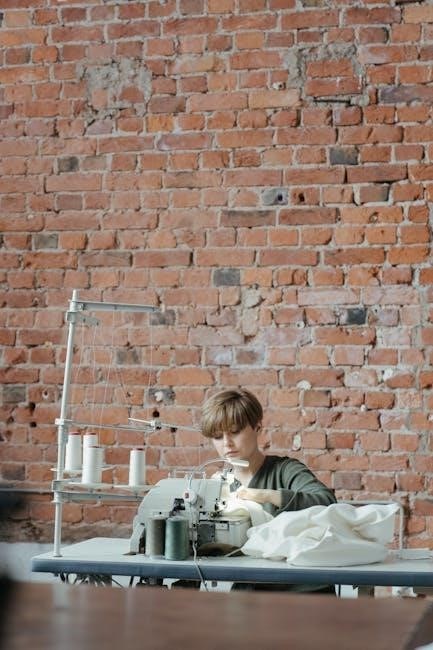
Resources for Further Learning
Explore downloadable PDF guides‚ online tutorials‚ and communities for in-depth learning. Websites like YouTube offer video tutorials‚ while forums provide tips and troubleshooting advice from experts.
9.1 Downloadable PDF Guides
Downloadable PDF guides are an excellent resource for mastering handheld sewing machines. These guides often include step-by-step instructions‚ diagrams‚ and troubleshooting tips.
They cover topics like threading‚ tension adjustment‚ and basic stitching techniques. Many manufacturers provide free PDF manuals on their websites;
Additionally‚ crafting platforms and sewing communities offer comprehensive guides tailored for beginners.
These PDFs are perfect for offline learning‚ allowing users to practice without internet access.
Popular platforms like Etsy and eBay also feature downloadable sewing guides at affordable prices.
Whether you’re repairing clothes or creating DIY projects‚ these resources are invaluable for improving your skills.
They ensure you get the most out of your handheld sewing machine with clear‚ detailed instructions.
9.2 Online Tutorials and Videos
Online tutorials and videos are a fantastic way to learn how to use a handheld sewing machine. Platforms like YouTube‚ Etsy‚ and crafting websites offer a wide range of instructional content.
These videos provide step-by-step guidance‚ demonstrating techniques like threading‚ stitching‚ and repairing fabrics.
Many tutorials are created by experienced sewists who share tips for getting the best results from your machine.
They often cover common mistakes and how to avoid them‚ making them ideal for beginners.
Some videos focus on specific projects‚ such as hemming pants or creating DIY crafts‚ while others offer in-depth troubleshooting advice.
With online tutorials‚ you can pause‚ rewind‚ and practice alongside the instructor‚ making the learning process more manageable.
These resources are accessible anytime‚ anywhere‚ and many are free to watch‚ making them a valuable tool for mastering handheld sewing machines.
They complement PDF guides by offering visual and auditory learning experiences.
9.4 Communities and Forums for Support
Joining online communities and forums is a great way to connect with other handheld sewing machine users.
These platforms‚ such as Facebook groups‚ Reddit forums‚ and specialized sewing communities‚ offer valuable support and advice.
Members often share tips‚ answer questions‚ and provide solutions to common issues.
You can learn from experienced users‚ gain inspiration for projects‚ and troubleshoot problems together.
Many communities host Q&A threads‚ live sessions‚ and challenges to help you improve your skills.
They also provide feedback on your work and encourage creativity.
These forums are especially helpful for beginners‚ as they offer a supportive environment to ask questions and learn.
Some groups even share free resources‚ including patterns and guides‚ to enhance your handheld sewing experience.
By participating in these communities‚ you can build connections and grow your sewing skills alongside others.
Handheld sewing machines offer convenience and versatility‚ making them ideal for both quick repairs and creative projects. Embrace their potential and happy sewing!
10.1 Final Thoughts on Handheld Sewing Machines
Handheld sewing machines are revolutionary tools that combine portability with functionality‚ making sewing accessible anywhere. Their ease of use and compact design empower creators to tackle repairs‚ DIY projects‚ and intricate designs effortlessly. Whether you’re a professional or a hobbyist‚ these machines offer unmatched convenience. The ability to sew on-the-go opens up endless possibilities for creativity and efficiency. By mastering the basics and maintaining your device‚ you can unlock its full potential. Embrace the freedom of handheld sewing and enjoy the satisfaction of crafting something with your own hands‚ no matter where inspiration strikes.
10.2 Encouragement for Beginners
Embrace the world of handheld sewing with confidence! As a beginner‚ it’s natural to feel unsure‚ but these machines are designed to be user-friendly. Start with simple projects like repairing small tears or sewing straight lines to build your skills. Don’t fear mistakes—they’re part of the learning process. Practice threading‚ tension adjustment‚ and stitching on scrap fabric to gain familiarity. Remember‚ every stitch brings you closer to mastering this versatile tool. With patience and practice‚ you’ll soon create beautiful‚ professional-looking results. Celebrate small victories‚ and don’t hesitate to explore tutorials or guides for additional support. Sewing is a skill that grows with time‚ and your handheld machine is the perfect companion on this creative journey.
10.3 Future Possibilities in Portable Sewing
Portable sewing machines are paving the way for exciting innovations in the future. Advances in technology could bring smarter‚ eco-friendly designs with improved battery life and quieter operation. Imagine machines with AI-driven stitching algorithms or integrated fabric sensors for flawless results. The rise of wearable technology might even inspire sewing machines that can be worn or carried effortlessly. As sustainability grows‚ handheld machines could incorporate recycled materials or solar power. These advancements will make portable sewing more accessible and versatile‚ empowering crafters and DIY enthusiasts worldwide. The future of sewing is portable‚ efficient‚ and full of creative potential.